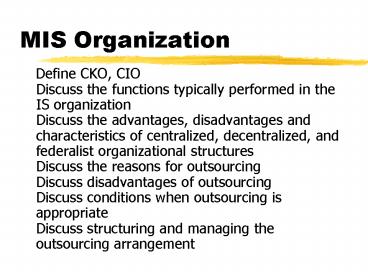MIS Organization - PowerPoint PPT Presentation
1 / 18
Title:
MIS Organization
Description:
Discuss the advantages, disadvantages and characteristics of centralized, ... Hustle (Staying alive) Creative and more realistic structuring of leases ... – PowerPoint PPT presentation
Number of Views:294
Avg rating:3.0/5.0
Title: MIS Organization
1
MIS Organization
- Define CKO, CIODiscuss the functions
typically performed in the IS organizationDiscuss
the advantages, disadvantages and
characteristics of centralized, decentralized,
and federalist organizational structuresDiscuss
the reasons for outsourcingDiscuss disadvantages
of outsourcingDiscuss conditions when
outsourcing is appropriateDiscuss structuring
and managing the outsourcing arrangement
2
Centralization Advantages Disadvantages
- PROS
- Global standards
- Common data
- One voice with suppliers
- Economies of scale
- Access to large capacity
- Better recruitment of IT personnel
- CONS
- Technology may not meet local needs
- Lack of business unit control
- Us vs. They
- Slow support for strategic initiatives
3
Decentralization Advantages Disadvantages
- ADVANTAGES
- Better meet local needs
- Closer partnership between IT and business units
- Greater flexibility
- Better match with decentralized enterprise
structure - Better unit control over overhead costs
- DISADVANTAGES
- Difficulty in maintaining global standards
consistent data - Higher infrastructure costs
- Loss of control
- Duplication of staff data
- Harder to negotiate preferential supplier
agreements
4
Federalism
- Hybrid approach
- Amalgamation of decentralized and centralized
approaches - May help gain strategic control and synergy
5
Outsourcing
- The purchase of a good or service that was
previously provided internally - Farm out data center operations (facilities
management) - Farm out tasks and services
- Farm out systems development
- May transfer IS function to vendor
6
Our Survey
- Companies written up in trade press for having
signed outsourcing agreements (1988 - 1993) - Telephone interviews
- 34 of 129 companies participated
- 30 financial institutions
- 25 private vs. 9 public
- Provided broad range of services
7
Goals Determinants of Outsourcing Success
- Core vs. commodity
- Partner vs. vendor
- Tight vs. loose contract
- Success Economic, Technical, Strategic, Overall
Satisfaction with Contract
8
Findings Primary Reasons for Outsourcing
- Technological considerations (8)
- Cost Savings (6)
- Strategic considerations (infrastructure building
- quickly) (5) - Human resource considerations (3)
- Mandated by central office/Acquired by another
company (3) - Consolidate Data Centers (2)
- Efficiency (1)
- Cash Infusion (1)
9
Findings Other
- Need tight contracts
- May be successful for core functions especially
if linked to tight contract - Can have successful partnerships
10
Saving Provider Advantages
- Tighter overhead cost control
- More aggressive use of low-cost labor pools
- More effective bulk purchases and leasing
arrangements - Better management of excess hardware capacity
- Better control over software licenses
- Hustle (Staying alive)
- Creative and more realistic structuring of leases
- Leaner management structure because of increased
competence and critical mass volumes of work
11
Outsourcing Disadvantages
- Reliance on vendor/partner
- Loss of control/ownership
- Considerations about security/confidentiality
- Evaporization of cost savings
- Loss of competitive advantage
- Slight of hand with employees
- High switching costs (contract problems)
- Lack of technological innovation
12
Outsourcing strategies
13
Outsourcing strategies
14
Structuring the Alliance
- Flexible contract ( a lot can happen over 10
years) - Shorten length
- Termination clause
- Detailed performance standards
- Service levels (terminal response times)
- Baseline period measurement
- Growth rates
- Service volume fluctuations
- Resolution of performance disputes
15
Structuring the Alliance
- Selective vs. full outsourcing
- Multiple vendors
- Cost savings
- Multiple evaluations
- Outside consultants
16
Structuring the Alliance
- Supplier stability and quality
- Conflict of interests
- Management fit
- Conversion problems
17
Managing the Alliance
- Strong CIO function
- Partnership/contract management
- Architecture planning
- Emerging technologies
- Continuous learning
18
Managing the Alliance
- Performance measurements continuous
- Low-structured tasks more difficult to outsource
- Low-structured task provide higher margins for
provider - Customer-outsourcer interface
- Specified account manager in provider company































